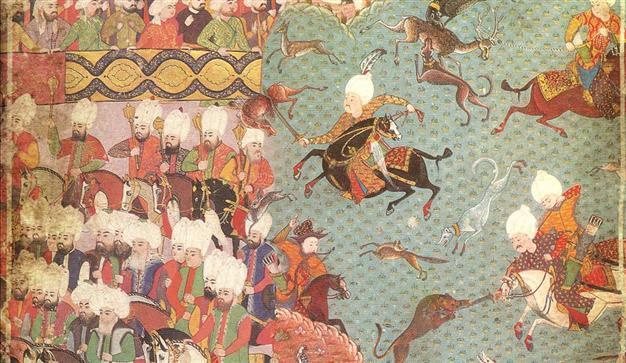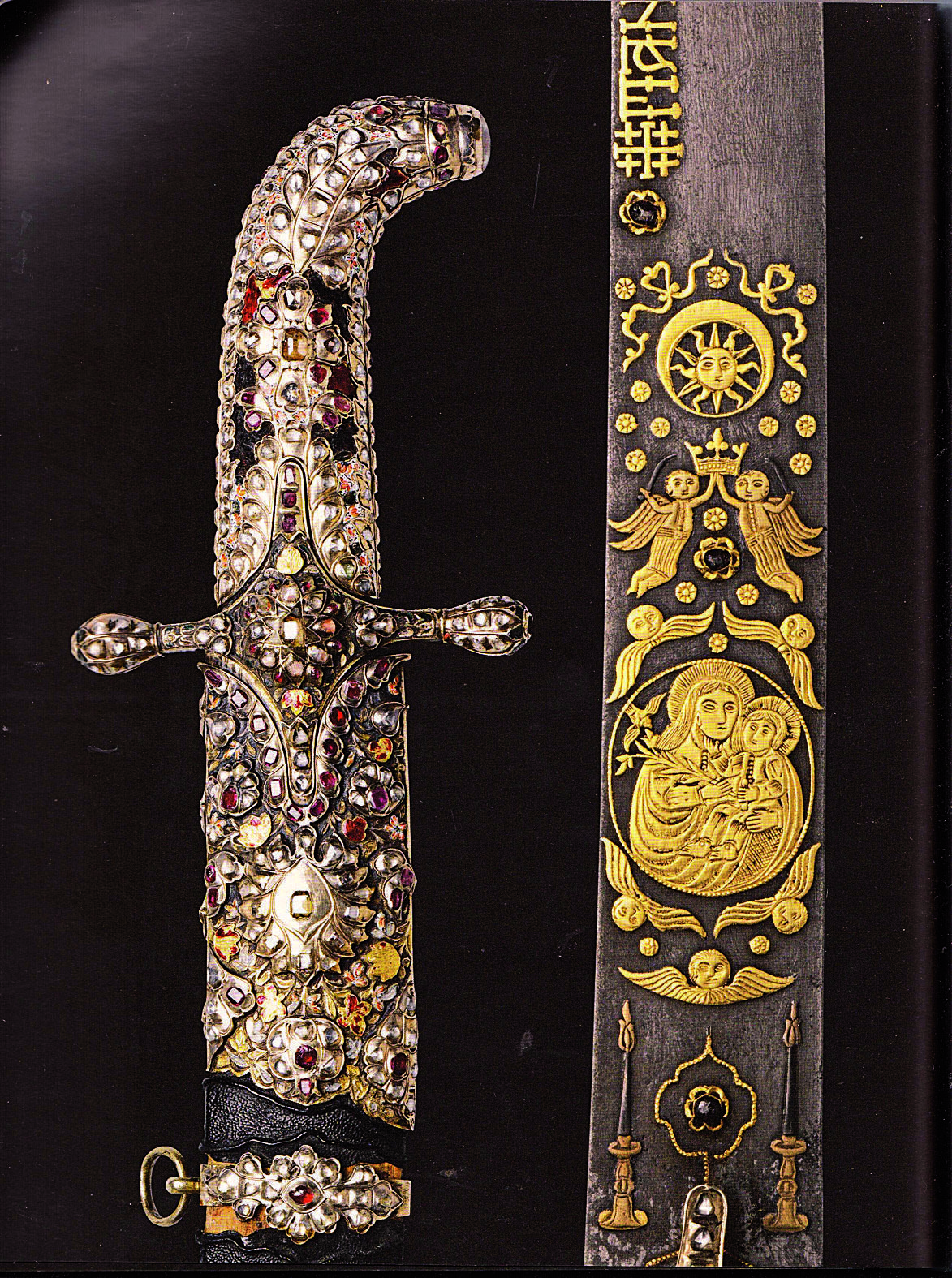The Ottoman sword - a cut and slash weapon
Niki GAMM

“The sword is a weapon used in personal combat for cutting or thrusting, one of the most ancient and highly esteemed of all weapons,” as one definition puts it. Although axes and spears / arrows seem to have been the earliest weapons, no sooner was the art of working metals discovered than the sword made its appearance. The earliest records come to us from the Middle East where initially the swords used were made of bronze. Tempering metal was first discovered in Galilee around the 13th or 12th centuries B.C. although it was not used to make swords initially. By the time of the Romans, tempered steel was the material of choice. The swords were straight, short and double-edged.
So how did it come about that Turkish swords were curved? Evidence so far points to the Turks using a curved sword as far back as the Xiongnu period in Central Asia (approximately from the third century BC to the second century AD). Some authorities believe that the Xiongnu were actually the Huns that invaded western Europe and that the Turks were a subgroup of the Xiongnu. The sword they developed was one-handed with a single steel blade and moderately curved. Another term for it was the saber. The Turkish word for sword is kılıç, possibly derived from the verb kir “to strike or kill” and inc is a suffix that gives the meaning of “instrument.” The letters ‘r’ and ‘l’ are interchangeable and the ‘n’ drops out to become the word kılıç.
When the Turks subsequently entered the Middle East, it was this curved sword that they brought with them and its use spread throughout the countries there. The Umayyad and Abbasid caliphates had Turks serving in their armies and Turkish slaves who were bought to serve in the Mamluke army in Egypt brought their curved swords with them. The successful advance of the Seljuk Turks into the Middle East in the tenth and eleventh centuries ensured the popularity of the curved blade as the favorite weapon of war replacing the straight blades previously favored.
Turkish kılıç
The Turkish kılıç which usually measured around 90 to 95 cm. has three parts, plus a scabbard, the blade, the cross-guard and the hilt. The blade was made of steel, curving to some extent from the hilt and curving more and widening over the last 30 percent or so towards the point. This distinguishes it from the swords used by European soldiers.
The Turkish cross guard which is located between the blade and the hilt was designed to prevent the wielder’s hand from slipping down along the blade. It never developed into the type of cross guard that in European swords helped protect the hand from being struck.
The hilt was curved in the opposite direction to the curve in the blade to prevent the sword from slipping out of the wielder’s hand. The hilt was often the most decorated part of the sword and was made from a variety of materials. Ahmet Ayhan in his book on the arms collection at Topkapi Palace Museum notes, “They were leather-wrapped wood, horn, ivory, fish teeth or similar materials, made from gold, silver or iron, and decorated with jade or other precious gems. Since wooden grips tended to decay over time, they were usually replaced. Therefore, discordance is often visible between the blade and hilt of most old swords.”
The scabbard is the sheath in which the sword is kept. Early scabbards were made of wood and covered with leather or velvet. Later metal became more popular because it did a better job of protecting the sharpness of the blade and offered a larger surface that could be decorated. At the top where the sword entered the scabbard there would be a loop or two from which a tie could be strung to ensure it didn’t fall when the sword was removed. Generally speaking, the Turkish sword was meant to be worn horizontally in a sash around the waist rather than hanging down from the waist. The kılıç has only one sharp edge and was used primarily for cutting and slashing rather than thrusting. It was made from two to three kilograms of iron. After it had been forged, it had to be tempered by quenching it in a special preparation whose secret was often jealously guarded. Thus the steel blade would be hard enough to cut armor to pieces. One recipe called for ingredients such as wild onion juice and burnt lime among other things. The mixture would be distilled and one oka (0.75 liters) would be enough for one sword.
Decorations
Decorations on the sword were done by etching. These usually consisted of praises to God and the Prophet Mohammed. Depending on the owner of the sword, his pedigree might be praised as is the case of the sword that belonged to Fatih Sultan Mehmed. In addition an aphorism might be included such as, “Forgiveness corrupts the treacherous and rehabilitates the virtuous.” Most of the inscriptions would be written in Arabic and were confined to the blade itself.As was often the case with Ottoman decorations elsewhere, floral and geometric patterns were among the most popular. While some of these might be on the blade, they were more typically placed on the cross guard, hilt and scabbard. Delicate leaves and flowers entwine to make unending bands that were often studded with precious or semi-precious stones.
During the height of the Ottoman Empire, the best of these swords were made in Bursa and Damascus and, while the Derbent region is mentioned, it is unclear whether this meant Konya or the Derbent located in today’s Dağıstan. The swords were exported. Nurhan Atasoy and Lale Uluc in their book, “Impressions of Ottoman Culture in Europe: 1453-1699” write that a seventeenth century prince of Transylvania asked his representative in Istanbul to purchase ornamented arms.
Often the most decorated would be among gifts presented to foreign rulers such as the sword that belonged to Russian Tsar Ivan Alekseevich. “The hilt and scabbard are decorated in the traditional Turkish style with golden studs with diamonds and rubies, but the blade has a gold inlaid image of the Virgin and Child and a four-pointed cross in a floral frame.” [From Treasures of the Moscow Kremlin at the Topkapı Palace] Such gifts didn’t necessarily have to be from ruler to ruler but might come from wealthy merchants trying to obtain trading concessions.
 “The sword is a weapon used in personal combat for cutting or thrusting, one of the most ancient and highly esteemed of all weapons,” as one definition puts it. Although axes and spears / arrows seem to have been the earliest weapons, no sooner was the art of working metals discovered than the sword made its appearance. The earliest records come to us from the Middle East where initially the swords used were made of bronze. Tempering metal was first discovered in Galilee around the 13th or 12th centuries B.C. although it was not used to make swords initially. By the time of the Romans, tempered steel was the material of choice. The swords were straight, short and double-edged.
“The sword is a weapon used in personal combat for cutting or thrusting, one of the most ancient and highly esteemed of all weapons,” as one definition puts it. Although axes and spears / arrows seem to have been the earliest weapons, no sooner was the art of working metals discovered than the sword made its appearance. The earliest records come to us from the Middle East where initially the swords used were made of bronze. Tempering metal was first discovered in Galilee around the 13th or 12th centuries B.C. although it was not used to make swords initially. By the time of the Romans, tempered steel was the material of choice. The swords were straight, short and double-edged. Decorations on the sword were done by etching. These usually consisted of praises to God and the Prophet Mohammed. Depending on the owner of the sword, his pedigree might be praised as is the case of the sword that belonged to Fatih Sultan Mehmed. In addition an aphorism might be included such as, “Forgiveness corrupts the treacherous and rehabilitates the virtuous.” Most of the inscriptions would be written in Arabic and were confined to the blade itself.As was often the case with Ottoman decorations elsewhere, floral and geometric patterns were among the most popular. While some of these might be on the blade, they were more typically placed on the cross guard, hilt and scabbard. Delicate leaves and flowers entwine to make unending bands that were often studded with precious or semi-precious stones.
Decorations on the sword were done by etching. These usually consisted of praises to God and the Prophet Mohammed. Depending on the owner of the sword, his pedigree might be praised as is the case of the sword that belonged to Fatih Sultan Mehmed. In addition an aphorism might be included such as, “Forgiveness corrupts the treacherous and rehabilitates the virtuous.” Most of the inscriptions would be written in Arabic and were confined to the blade itself.As was often the case with Ottoman decorations elsewhere, floral and geometric patterns were among the most popular. While some of these might be on the blade, they were more typically placed on the cross guard, hilt and scabbard. Delicate leaves and flowers entwine to make unending bands that were often studded with precious or semi-precious stones.